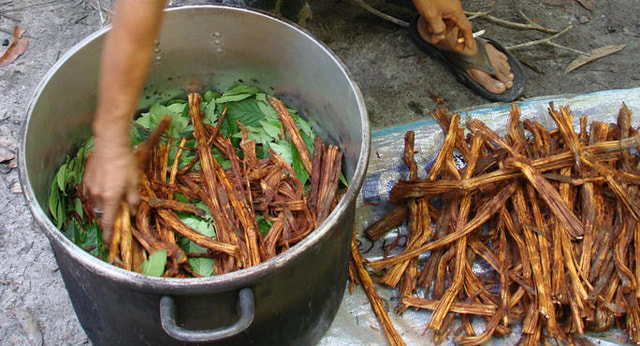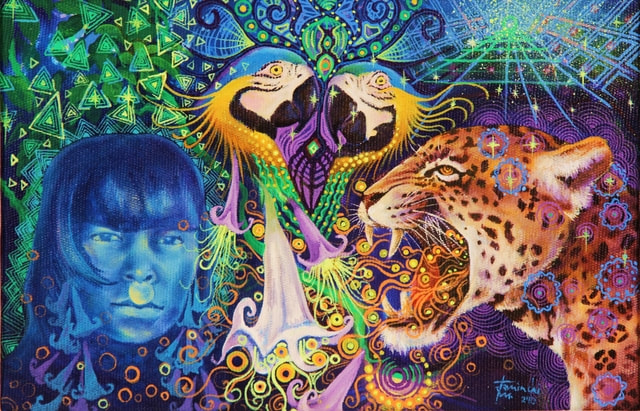Ayahuasca is becoming increasing well known across the globe as people from all walks of life are being exposed to this shamanic brew. In 2016, The New Yorker, Business Insider, and The Guardian all published pieces regarding the boom in Ayahuasca ceremonies taking place throughout the world including unlikely locations such as New York and the San Francisco Bay Area. As many of you well know, the ingredients within Ayahuasca comprise of DMT and a monoamine oxidase inhibitor (MAOI). Generally speaking the ingredients utilized for Ayahuasca are comprised of Psychotria Viridis which provides the N,N-dimethyltryptamine (DMT) and Banisteriopsis Caapi (B. Caapi) which provides the MAOI properties. I utilize the term “generally speaking” being that different shamans utilize different combinations of plants with a slight variation of effects.
While DMT Quest has extensively postulated the systemic mechanisms for endogenous synthesis and release of 3 different forms of DMT (N,N-dimethyltryptamine (DMT), 5-methoxy-dimethyltryptamine (5-MeO-DMT), and N,N-dimethyl-5-hydroxytryptamine (Bufotenine)), it would seem pertinent to take a look at endogenously produced MAOIs. The reason that MAOIs are integrated within Ayahuasca are due to the fact that the enzyme monoamine oxidase degrades orally ingested DMT via a process called deamination. The MAOIs essentially provide protection for DMT from the deamination process which subsequently leads to retainment of oral activation.

A 150 pound person can ingest 50 mg of DMT via Ayahuasca with a peak effect at roughly 90 minutes with dwindling effects lasting 3-4 hours. That same person could vaporize/smoke 50 mg of DMT and experience extremely intense effects lasting only 10-15 minutes. However, if that person were to ingest an MAOI prior to vaporization/smoking of the DMT, it’s been reported to extend the intense effects for 45 minutes to an hour. This makes it rather straightforward that MAOIs not only allow for oral activation of exogenous DMT but that they also provide protection from DMT degradation irregardless of the source.
(If we want to be completely technical, a person might be able to induce two extremely intense sessions of vaporized DMT with 50 mg (25 mg two different times). However, combining the time of both would only equate to 20-30 minutes total.)This bit of information would seem rather important especially when postulating the internal mechanisms for our nightly “dream state”. Being that an average human sleeps for 8 hours a night and is constantly drifting in and out of dreams, either we can postulate that there is a constant source of DMT being produced to induce these dreams and/or there is a constant source of MAOIs preventing the degradation of our endogenously produced DMT.In 1988, Dr. J.C. Callaway would publish a paper in the journal Medical Hypotheses titled “A Proposed Mechanism for the Visions of Dream Sleep”. In this piece, he speculates that endogenous production of DMT and MAO-A inhibitor, Pinoline possibly play a distinct role in dream phenomena. Callaway also cites a 1981 article in the journal Medical Biology which outlines additional compounds within the body that can act as MAOIs.
From conducting some basic research, DMT Quest has found what seems to be 5 additional compounds in the body that act as MAO-A inhibitors in addition to Pinoline.
1. Tryptoline
2. Harman (sometimes named Harmane)
3. Neurocatin
4. Tribulin A
In humans there are two forms of monoamine oxidase… MAO-A and MAO-B. Both types are found throughout the central nervous system. MAO-A is also found in the liver, lungs, and digestive tract while MAO-B is largely found in the platelets.
It is MAO-A that seems to be the main focus in terms of the effects of B. Caapi in Ayahuasca although a 2010 study published in the Journal of Ethnopharmacology showed modest inhibition of MAO-B as well.
From what we’ve researched thus far, there appears to be 3 endogenously produced MAO-B inhibitors.
3. Tribulin B
From what it seems thus far, there is the potentiality for numerous other MAO-A and MAO-B inhibitors to be identified in the future.
A 1986 study in the Journal of Neural Transmission showcased the effects of synthetic MAOIs on melatonin release and pineal gland function. The results were as follows: “Monoamine oxidase (MAO)-inhibiting antidepressants increase pineal concentrations of the melatonin precursors, serotonin (5-HT) and N-acetyl serotonin (NAS), in rodents, and also increase pineal N-acetyl transferase activity as well as both daytime and nighttime plasma melatonin concentrations; they also elevate melatonin, 5-HT and NAS in the cerebrospinal fluid of non-human primates. In humans treated with the MAO-A selective inhibitor, clorgyline, or the nonselective inhibitor, tranylcypromine, increased plasma melatonin also occurs; in contrast, the MAO-B selective inhibitor, 1-deprenyl, does not affect plasma melatonin.”
A 1988 study published in the Archives of General Psychiatry showcased the effects of MAO inhibitors as well as other antidepressants on noradrenaline and melatonin output. The results in regards to the MAOIs are as follows: “Both clorgiline and tranylcypromine, the MAO type A inhibitor and the nonselective MAO inhibitor used in our study, increased morning plasma melatonin concentrations in depressed patients following long-term (three week) treatment; the MAO type B inhibitor deprenyl (selegiline), in contrast, did not increase plasma melatonin levels, suggesting that inhibition of MAO type A by either a selective or nonselective MAO inhibitor can increase pineal melatonin output.”
These studies are intriguing based on the notion that endogenous MAO-A inhibitors potentially have a direct effect on pineal gland function and subsequently melatonin production. DMT Quest has extensively postulated the seemingly precursor-like qualities that melatonin exudes as it relates to DMT. Unfortunately there are very little direct studies in regards to the physiological changes that lead to increased levels of endogenous MAO-A inhibiting compounds. A 2008 study in the journal Current Biology alludes to the fact that MAO-A activity is regulated by circadian-clock components. Based on utilizing all the information covered at DMT Quest thus far, it would seem that the same parameters that induce altered states (darkness, increased slow brainwaves, rhythmic respiration) likely induce an increase in endogenous MAOI production.

Nevertheless it seems clear that humans naturally possess virtually identical components to the vaunted Ayahuasca brew. It seems as though there are 2 key pitfalls in terms of understanding the mechanisms for “Endohuasca” experiences and they boil down to A) equipment sensitivity and B) a lack of research funds available for this endeavor. Regardless of these factors, it’s amazing that humans and potentially many other animals possess this biochemical soup of a psychedelic nature.
Some will state that humans possess far too low of levels regarding any and all of these compounds (DMT’s and MAOIs) to induce any effects on-par with Ayahuasca. I respond with… neither you nor I have any definitive answers as to the levels of any of these substances within the human brain in real-time when we are fully immersed in the “dream state” at 3am. One thing that we definitively know is that there are distinct, measurable changes in the brain during these moments utilizing EEG, Direct Current measurement and fMRI equipment compared to “regular” waking consciousness. This doesn’t even include the fact that the brain activity during dream sleep shares much similarity to that observed during Ayahuasca sessions and psilocybin ingestion.As we’ve cited in a prior piece, a 2008 study in the Journal of Cerebral Blood Flow and Metabolism showcased levels of melatonin in cerebrospinal fluid (CSF) increasing nearly 500% following traumatic brain injury compared to only a 50% increase in blood. This leads us to believe that the levels of these “Endohuasca” components measured in the blood do not accurately reflect the levels or fluctuations observed in cerebrospinal fluid as well as the brain. One interesting anecdotal claim that has been consistently touted throughout the psychonautical interwebs are the effects of ingesting solely B. Caapi or Syrian Rue (both legal, natural MAOIs) without the addition of DMT. It’s been reported by more than a handful of people that the MAOI alone led to inducing a psychedelic state of varying degrees based on the individual and amount ingested.
A 2005 study in the Journal of Psychoactive Drugs analyzed the level of DMT in 36 different samples of Psychotria Viridis (the plant traditionally utilized to provide DMT for Ayahuasca). The study found that one sample contained no DMT at all and 8 samples contained less than 0.60 mg/g. It makes one wonder if the combination of the night time setting, purging (which induces slight metabolic alkalosis), and chanting/music (altered EEG state) combined with MAOIs provide the combination to tap into one’s own endogenous DMT rather than predominantly relying on exogenous sources for effect. It would in essence be the ultimate “placebo” effect… somewhat.
(The “placebo effect” simply means that the exogenous compound ingested is not directly responsible for the end result. In this case of the Aya/Endohuasca combination it’s obvious that many measurable changes across different physiological systems are taking place. This is distinctly different than the traditional perception of the “placebo effect” in which one’s physiology didn’t change drastic enough to cause the actual effect. If that makes any sense…)
The human body is indeed magical and possessing the components for “Endohuasca” is one of the greatest mysteries that the science world has yet to scratch the surface of. It’s important to note that while DMT within itself is one hell of an interesting molecule found to reside within us, the monoamine oxidase inhibitors go hand in hand with “The Spirit Molecule”.
Some might say that the MAOIs play an even more important role than DMT itself…
(A 2001 study in the journal Life Sciences showcases the powerful effect of hydroxyl radicals (a neutral form of hydroxide ions) on monoamine oxidase inhibition (MAO-A & MAO-B). It appears as though hydroxyl formation directly coincides with respiratory fluctuations.)
DMT Quest is a non-profit 501(c)3 dedicated to raising awareness and funds for endogenous DMT Research. This specific field of psychedelic research has been underfunded for many decades now. It’s time to take our understanding of human physiology, abilities, and perception to the next level. E-mail me at jchavez@dmtquest.org with any comments or questions. You can also follow us at Facebook, Instagram, or Twitter.
